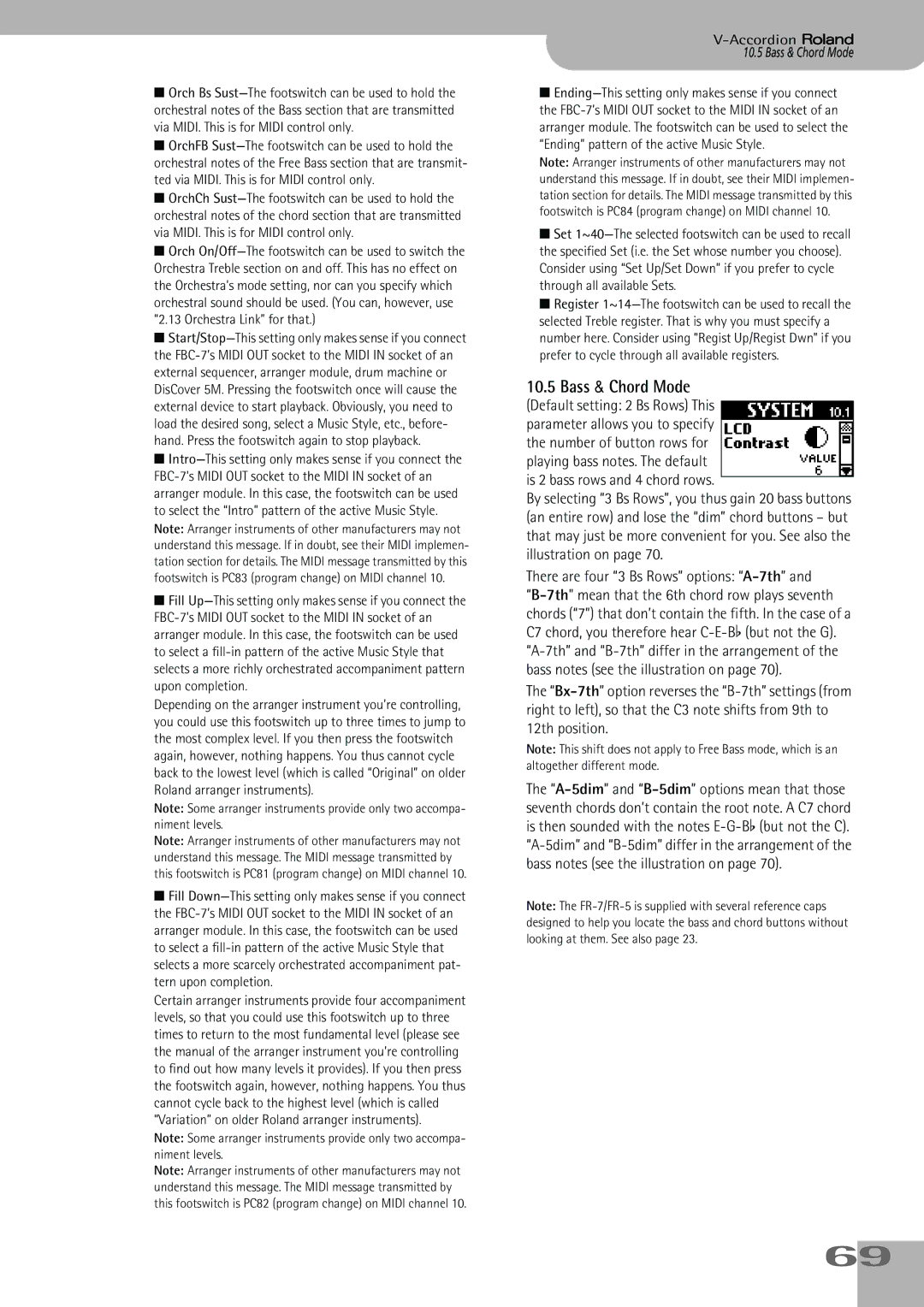■Orch Bs Sust—The footswitch can be used to hold the orchestral notes of the Bass section that are transmitted via MIDI. This is for MIDI control only.
■OrchFB Sust—The footswitch can be used to hold the
orchestral notes of the Free Bass section that are transmit- ted via MIDI. This is for MIDI control only.
■OrchCh Sust—The footswitch can be used to hold the orchestral notes of the chord section that are transmitted via MIDI. This is for MIDI control only.
■Orch On/Off—The footswitch can be used to switch the Orchestra Treble section on and off. This has no effect on the Orchestra’s mode setting, nor can you specify which orchestral sound should be used. (You can, however, use “2.13 Orchestra Link” for that.)
■Start/Stop—This setting only makes sense if you connect the FBC-7’s MIDI OUT socket to the MIDI IN socket of an external sequencer, arranger module, drum machine or DisCover 5M. Pressing the footswitch once will cause the external device to start playback. Obviously, you need to load the desired song, select a Music Style, etc., before- hand. Press the footswitch again to stop playback.
■Intro—This setting only makes sense if you connect the FBC-7’s MIDI OUT socket to the MIDI IN socket of an arranger module. In this case, the footswitch can be used to select the “Intro” pattern of the active Music Style.
Note: Arranger instruments of other manufacturers may not understand this message. If in doubt, see their MIDI implemen- tation section for details. The MIDI message transmitted by this footswitch is PC83 (program change) on MIDI channel 10.
■Fill Up—This setting only makes sense if you connect the FBC-7’s MIDI OUT socket to the MIDI IN socket of an arranger module. In this case, the footswitch can be used to select a fill-in pattern of the active Music Style that selects a more richly orchestrated accompaniment pattern upon completion.
Depending on the arranger instrument you’re controlling, you could use this footswitch up to three times to jump to the most complex level. If you then press the footswitch again, however, nothing happens. You thus cannot cycle back to the lowest level (which is called “Original” on older Roland arranger instruments).
Note: Some arranger instruments provide only two accompa- niment levels.
Note: Arranger instruments of other manufacturers may not understand this message. The MIDI message transmitted by this footswitch is PC81 (program change) on MIDI channel 10.
■Fill Down—This setting only makes sense if you connect the FBC-7’s MIDI OUT socket to the MIDI IN socket of an arranger module. In this case, the footswitch can be used to select a fill-in pattern of the active Music Style that selects a more scarcely orchestrated accompaniment pat- tern upon completion.
Certain arranger instruments provide four accompaniment levels, so that you could use this footswitch up to three times to return to the most fundamental level (please see the manual of the arranger instrument you’re controlling to find out how many levels it provides). If you then press the footswitch again, however, nothing happens. You thus cannot cycle back to the highest level (which is called “Variation” on older Roland arranger instruments).
Note: Some arranger instruments provide only two accompa- niment levels.
Note: Arranger instruments of other manufacturers may not understand this message. The MIDI message transmitted by this footswitch is PC82 (program change) on MIDI channel 10.
V-Accordion r
10.5 Bass & Chord Mode
■Ending—This setting only makes sense if you connect the FBC-7’s MIDI OUT socket to the MIDI IN socket of an arranger module. The footswitch can be used to select the “Ending” pattern of the active Music Style.
Note: Arranger instruments of other manufacturers may not understand this message. If in doubt, see their MIDI implemen- tation section for details. The MIDI message transmitted by this footswitch is PC84 (program change) on MIDI channel 10.
■Set 1~40—The selected footswitch can be used to recall the specified Set (i.e. the Set whose number you choose). Consider using “Set Up/Set Down” if you prefer to cycle through all available Sets.
■Register 1~14—The footswitch can be used to recall the selected Treble register. That is why you must specify a number here. Consider using “Regist Up/Regist Dwn” if you prefer to cycle through all available registers.
(Default setting: 2 Bs Rows) This parameter allows you to specify the number of button rows for playing bass notes. The default is 2 bass rows and 4 chord rows.
By selecting “3 Bs Rows”, you thus gain 20 bass buttons (an entire row) and lose the “dim” chord buttons – but that may just be more convenient for you. See also the illustration on page 70.
There are four “3 Bs Rows” options: “A-7th” and
“B-7th” mean that the 6th chord row plays seventh chords (“7”) that don’t contain the fifth. In the case of a C7 chord, you therefore hear C-E-Bb (but not the G). “A-7th” and “B-7th” differ in the arrangement of the bass notes (see the illustration on page 70).
The “Bx-7th” option reverses the “B-7th” settings (from right to left), so that the C3 note shifts from 9th to 12th position.
Note: This shift does not apply to Free Bass mode, which is an altogether different mode.
The “A-5dim” and “B-5dim” options mean that those seventh chords don’t contain the root note. A C7 chord is then sounded with the notes E-G-Bb (but not the C). “A-5dim” and “B-5dim” differ in the arrangement of the bass notes (see the illustration on page 70).
Note: The FR-7/FR-5 is supplied with several reference caps designed to help you locate the bass and chord buttons without looking at them. See also page 23.

